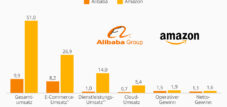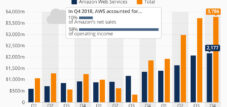Amazon's shock layoffs: Why jobs are no longer secure even in booming companies
Xpert pre-release
Language selection 📢
Published on: October 28, 2025 / Updated on: October 28, 2025 – Author: Konrad Wolfenstein

Amazon's shock layoffs: Why even in booming companies, jobs are no longer secure – Image: Xpert.Digital
Amazon's job cuts in the wake of the AI revolution | Record profits and yet mass layoffs: What's really behind Amazon's radical move?
When profitability meets jobs: The fine line between innovation and social responsibility
Amazon's announcement that it will cut at least 14,000 administrative jobs marks a significant turning point in the global debate about the impact of artificial intelligence on the world of work. While the company officially speaks of organizational changes and efficiency improvements, various sources indicate that up to 30,000 jobs could be affected in several waves. This development cannot be viewed in isolation but must be understood in the context of a fundamental transformation of the digital economy, in which technological disruption and economic rationality are creating new power relations in the labor market.
Suitable for:
The immediate dimensions of the job cuts
The announced layoffs primarily affect Amazon's administrative department, with approximately 4 percent of the approximately 350,000 employees in corporate functions set to lose their jobs. According to media reports, the human resources department, in particular, could be hit particularly hard, with a reduction of around 15 percent. The majority of affected employees will be given 90 days to apply for other positions internally. This appears, on the one hand, to be a social cushion, but on the other hand also reveals the reality that in a shrinking administrative apparatus, the opportunities for successful internal repositioning are limited.
The timing of this move is remarkable. Amazon massively expanded its workforce during the coronavirus pandemic between 2020 and 2022, more than doubling its workforce. Between January and October 2020 alone, the company hired an average of 1,400 new employees daily, growing its global workforce to over 1.2 million people, an increase of more than 50 percent within a single year. This expansion followed the explosive demand for online shopping during the lockdowns, when millions of people were forced to digitize their consumption habits.
Now, in 2025, a correction of these pandemic-related overcapacities is taking place. But the current wave of layoffs goes beyond a mere adjustment to normalized demand. It is part of a strategic realignment that CEO Andy Jassy has consistently pursued since taking office in 2021. Jassy has repeatedly spoken of excessive bureaucracy within the company and launched an initiative to run Amazon like the world's largest startup. He encouraged employees to report inefficiencies via an anonymous complaints center, which resulted in over 1,500 responses and more than 450 process changes.
The economic logic behind the reduction in staff
Amazon's financial situation presents a seeming paradox. The company is reporting robust business figures, with revenue growth of 13 percent in the second quarter of 2025 to $167.7 billion and operating profit of $19.2 billion, representing a 31 percent increase. Net profit jumped by more than a third to $18.2 billion. Despite these successes, or perhaps because of them, Amazon is implementing radical job cuts. This decision follows a business logic that is becoming increasingly dominant in the technology industry.
Amazon Web Services, the cloud division traditionally the company's profit engine, grew by 17.5 percent to $30.9 billion in revenue in the second quarter of 2025. However, this growth rate fell significantly short of expectations and, more importantly, behind its competitors. Microsoft Azure recorded 39 percent growth over the same period, while Google's cloud business grew by nearly 32 percent. Even more worrying for investors was the development of AWS's profit margin, which fell to 32.9 percent in the second quarter of 2025, compared to 39.5 percent in the first quarter and 35.5 percent in the same quarter of the previous year. This was the lowest margin since the fourth quarter of 2023.
This development is putting Amazon under considerable pressure. The company is investing heavily in expanding its AI infrastructure, with capital investments of over $31 billion in the second quarter of 2025 alone. Analysts expect these investments to continue at a similar pace in the second half of the year. To justify these enormous expenditures while maintaining profitability, costs must be cut elsewhere. Reducing administrative staff seems like an obvious option, especially if artificial intelligence promises to automate many of these functions.
The financial markets' reaction to the layoff announcement is revealing. Amazon shares initially rose by 1.2 percent on the day of the announcement, signaling that investors interpret the job cuts as a positive sign for cost discipline and thus for future profitability. This is in line with a tradition established in the technology industry since 2022. When Google announced the layoff of 12,000 employees in early 2023, its share price rose by 3.5 percent. Meta's stock, which had fallen 63 percent in 2022, recovered dramatically after the company cut 21,000 jobs.
The role of artificial intelligence as a catalyst
Amazon's central justification for the job cuts lies in the transformative power of artificial intelligence. Beth Galetti, Senior Vice President of People Experience and Technology, articulated this clearly in her message to employees: This generation of AI is the most transformative technology since the internet, enabling companies to innovate at unprecedented speeds. To respond to these changes, Amazon needs to be leaner, with fewer hierarchical levels and more autonomy.
CEO Andy Jassy had already stated in June 2025 that the increased use of artificial intelligence tools would likely lead to further job cuts, particularly through the automation of repetitive and routine tasks. This assessment is not based on speculation, but on measurable productivity gains that Amazon has already realized through the use of AI. A major Big Four consulting firm was able to shorten its research cycles by 75 percent through the use of AI, according to industry reports.
The areas of application for generative AI in everyday office life are diverse. AI systems can already compose texts, create summaries, analyze data, handle customer inquiries, and automate administrative processes. Programs like ChatGPT or Claude, developed by Amazon-funded developer Anthropic, are capable of independently performing certain knowledge tasks and automating administrative processes. This applies precisely to the areas where Amazon is currently reducing staff.
A recent survey of German companies by the Munich-based Ifo Institute shows that 27.1 percent of firms expect that artificial intelligence will lead to job cuts in the next five years. In manufacturing, more than a third of companies anticipate AI-related job cuts. If job cuts do occur, the affected companies expect an average reduction of around 8 percent of their workforce. Goldman Sachs estimates that up to 300 million full-time jobs worldwide could be affected by automation through generative AI.
The strategic context of the platform economy
To fully understand Amazon's decision, one must consider the specific logic of the platform economy. Amazon operates as a multi-sided marketplace connecting sellers and buyers, cloud customers and service providers, content producers and consumers. This platform structure is subject to specific economic principles, particularly indirect network effects. The more sellers are represented on the platform, the more attractive it becomes for buyers, and vice versa. This dynamic leads to self-reinforcing growth effects and explains why platform markets are often referred to as winner-takes-most markets.
Platforms like Amazon traditionally pursue an expansion strategy based on growth before profit. They rely on aggressive market expansion and predatory pricing strategies, often operating at a loss for years. This strategy is made possible by large sums of venture capital, for which the platform companies themselves become objects of speculation. But now that Amazon has established its dominant market position, the focus is shifting from growth to profitability. The current layoffs are part of this strategic realignment.
The market power of platforms is expressed less towards consumers than towards service providers. Due to its market position, Amazon can dictate conditions to which third-party providers must comply if they do not want to lose market access. This structural power also enables Amazon to rigorously enforce efficiency gains internally. The affected employees have little bargaining power, especially since many of them were hired during the pandemic and now serve as adjustment variables for strategic realignments.
The wave of layoffs in the industry-wide context
Amazon's job cuts are not an isolated phenomenon, but part of an industry-wide consolidation in the technology industry. Since 2022, tech companies have eliminated hundreds of thousands of jobs in several waves. A total of 165,000 jobs were eliminated in the technology industry in 2022, followed by another 250,000 layoffs in 2023. In the first quarter of 2024 alone, 34,000 employees were laid off, more than in four of the eight previous three-month periods since the beginning of 2022.
The industry's biggest names are all affected. Meta laid off 21,000 employees, Google 12,000, Microsoft 10,000, and Amazon itself had already eliminated around 27,000 positions by the end of 2022. SAP announced 8,000 layoffs, and Salesforce 10 percent of its workforce. This development follows a common pattern. The tech companies had massively hired during the pandemic to keep pace with exploding demand. Meta increased its workforce by 60 percent between 2019 and 2021, from just under 45,000 to 72,000 employees. Microsoft, Alphabet, and Amazon recorded similarly strong increases.
As the pandemic subsided, demand normalized, and companies realized that their workforce capacity exceeded actual needs. But the current waves of layoffs go beyond a mere correction of excess capacity. They are part of a strategic reorientation toward artificial intelligence. Companies are heavily investing in AI technologies that promise to enable productivity gains while simultaneously reducing personnel costs. An analysis of tech layoffs shows that 25 percent of employees have already experienced an impact on their job security due to AI.
The productivity paradox of digital transformation
A remarkable phenomenon of current developments is the productivity paradox. Despite massive investments in digital technologies and artificial intelligence, there has been no corresponding increase in overall economic productivity so far. Labor productivity growth in Germany declined by 1.55 percent per year between 1992 and 2010 and by 1.10 percent per year between 2010 and 2018, despite all efforts toward digital transformation. This phenomenon is known as the productivity paradox and was already observed in earlier phases of the IT revolution.
As early as 1987, economist Robert Solow famously stated: "You see computers everywhere, except in productivity statistics." Several explanations for this paradox have been discussed. First, technological innovations take time to translate into measurable productivity gains. Organizations must learn to use the new technologies effectively, business processes must be redesigned, and employees must be trained. Second, measurement inaccuracies may play a role, particularly in digital services, whose added value is difficult to quantify. Third, productivity gains may be unevenly distributed, so that some companies and sectors benefit massively while others stagnate.
Goldman Sachs predicts that generative AI could lead to a productivity increase of 1.5 percent per year, almost double the growth rate between 2010 and 2018. McKinsey is even more optimistic, expecting AI and other forms of automation to drive productivity to 3.3 percent per year by 2040. However, these forecasts are based on assumptions about future developments, while the empirical evidence to date is mixed. A study based on the German Innovation Survey shows that while the use of AI leads to higher sales of new market innovations and higher returns, it does not lead to an increase in productivity in companies using AI.
The socioeconomic implications of AI-driven job cuts
The impact of Amazon's downsizing and the broader AI-driven rationalization on society is complex and potentially profound. First, there is the question of distributive justice. Who benefits from AI's productivity gains, and who bears the costs in the form of job losses? Evidence to date suggests that the winners of digitalization are primarily highly skilled mobile workers, capital owners, and entrepreneurial pioneers. The losers are often found in the middle of the wage spectrum, in jobs with a high proportion of routine work.
Studies show that automation contributes to rising wage and income inequality. Labor tends to lose out to capital. Absolute real wage losses are to be feared in the middle of the wage spectrum. This pattern is already evident today and could intensify in the future. The question is not only whether enough jobs will remain, but also what these jobs are worth if they are poorly paid. Falling real wages in the middle of the wage spectrum pose considerable social dynamite.
The structure of the labor market is changing fundamentally. Entry-level professionals are particularly affected, as junior positions disappear and traditional career paths become rarer. AI is acting as a catalyst for this change, while offshoring and budget discipline are amplifying the effect. In the long term, a shortage of executives could loom as entry-level and middle management positions are eliminated. This makes talent development more difficult, both economically and culturally. Demand for developers is declining as large companies automate analysis and research work.
The challenges of qualification and further training
Technological change requires massive adaptation from employees and education systems. Skills requirements are changing rapidly. In addition to basic digital skills, interdisciplinary skills are becoming increasingly important. Creativity, emotional intelligence, problem-solving skills, and the ability to continuously learn are gaining importance. Technological progress replaces routine, but not interpersonal skills and complex cognitive abilities.
However, the reality of in-company continuing education does not meet these needs. Studies show that while in-company continuing education rates increase after investments in digital technologies, it is primarily higher-skilled employees who benefit most. The expansion of continuing education for low-skilled employees often fails to materialize during corporate transformation processes. Employees at risk from automation participate in continuing education less frequently than colleagues at lower risk. This exacerbates social inequality and prevents broad participation in the opportunities offered by digitalization.
Policymakers face the challenge of creating frameworks that, on the one hand, promote innovation and productivity growth while, on the other, preventing social disruption. This requires massive investments in education and training, a modernization of social systems, and potentially new forms of redistribution. Among the options being discussed are a universal basic income, a robot tax, and increased taxes on capital income. The challenge is to translate the resulting productivity gains into broad prosperity without causing major disruption in certain occupational groups.
🎯🎯🎯 Benefit from Xpert.Digital's extensive, five-fold expertise in a comprehensive service package | BD, R&D, XR, PR & Digital Visibility Optimization

Benefit from Xpert.Digital's extensive, fivefold expertise in a comprehensive service package | R&D, XR, PR & Digital Visibility Optimization - Image: Xpert.Digital
Xpert.Digital has in-depth knowledge of various industries. This allows us to develop tailor-made strategies that are tailored precisely to the requirements and challenges of your specific market segment. By continually analyzing market trends and following industry developments, we can act with foresight and offer innovative solutions. Through the combination of experience and knowledge, we generate added value and give our customers a decisive competitive advantage.
More about it here:
Amazon's dual strategy: job cuts in administration, billions for AI
The fragility of lean organizational structures
An often overlooked aspect of the current wave of rationalization is the fragility that comes with extremely lean organizational structures. Efficiency gains do not automatically equate to resilience. The Swedish fintech company Klarna had to backtrack after an AI-driven downsizing when it became clear that the remaining capacity was insufficient to respond to unexpected challenges. Lean organizations can quickly reach their limits when faced with shocks such as supply chain crises, cyberattacks, or AI malfunctions.
A focus on short-term efficiency gains can jeopardize long-term competitiveness. Companies need a certain degree of redundancy to remain innovative and respond to changing market conditions. Laying off experienced employees can lead to a loss of knowledge that is difficult to recover. Remaining employees have to take on more responsibilities, which can lead to overwork and burnout. Corporate culture can suffer when employees live in constant uncertainty and loyalty is replaced by fear.
Suitable for:
The global dimension of labor force restructuring
Amazon's layoffs affect not only the US, but employees worldwide. In Germany, Amazon employs around 40,000 people at over 100 locations, including fulfillment centers, administrative offices in Munich and Berlin, and development sites such as Aachen. 4,000 new jobs were added within a year. It is currently unclear how many of the announced layoffs will be in Germany. Consumers in Germany and other parts of Europe are unlikely to feel the impact of the layoffs, as only administrative areas are affected, while employees in fulfillment centers or retail, who usually work for subcontractors, are not affected.
At the same time, Amazon is investing more in Europe than ever before. The company plans to invest approximately €14 billion in Germany in 2024, two billion more than last year. German CEO Rocco Bräuniger announced that he will further increase the pace of investment, with a particular focus on the automation of logistics, particularly the increased use of robots. This seemingly contradictory development—reduction in administrative staff while simultaneously investing in infrastructure and automation—illustrates the fundamental transformation of the business model. Human labor is not simply being replaced, but redistributed and reconfigured.
The role of the AWS division as a strategic driver
The cloud division, Amazon Web Services, plays a central role in the strategic direction of the entire group. AWS contributes approximately 20 percent of group revenue but approximately 60 percent of profit. In the third quarter of 2025, AWS achieved an operating profit of $10.4 billion on revenue of $27.5 billion, corresponding to an operating margin of approximately 38 percent. This exceptionally high profitability makes AWS the cash cow of the Amazon empire and finances investments in other business areas.
But AWS's growth momentum has slowed. While Microsoft Azure and Google Cloud are experiencing higher growth rates, AWS is stagnating at around 17 to 19 percent growth per quarter. Analysts warn that if current growth rates continue, Microsoft Azure could overtake AWS as the world's largest cloud provider by the end of 2026. This is putting massive pressure on Amazon. The company is investing aggressively in AI infrastructure and new cloud services to defend its leadership position. Partnerships with Toyota, T-Mobile, and Epic Games are intended to strengthen its market position.
The massive investment in AI capabilities must be refinanced. Amazon has announced it will invest $10 billion in building a campus in North Carolina to expand its cloud computing and AI capabilities. Similar investments are planned for locations in Mississippi, Indiana, and Ohio. These sums illustrate the scale of the competition for dominance in the AI cloud business. To justify these investments and stabilize margins, costs must be cut elsewhere. Administrative staff reductions are part of this equation.
The transformation of the business model as a strategic imperative
Amazon's job cuts are not just a reaction to short-term market conditions, but part of a fundamental transformation of its business model. The company is evolving from an online retailer into a diversified technology group with a focus on cloud computing, artificial intelligence, advertising, streaming, and physical retail. This diversification creates synergies between the various business units. Prime subscribers benefit from exclusive offers on the marketplace, while AWS technologies increase the efficiency of Amazon's internal processes. Devices like Alexa and Echo promote the use of other Amazon services.
The strength of the Amazon ecosystem lies in the tight integration of its various services. Customers are becoming increasingly deeply integrated into the ecosystem, giving Amazon unparalleled market power. However, this strategy requires a highly efficient organization capable of responding quickly to market changes and integrating new technologies. Bureaucratic structures and redundant management levels are seen as an obstacle to this agility. CEO Jassy aims to run Amazon like the world's largest startup, with flat hierarchies, high levels of personal responsibility, and fast decision-making processes.
The ethical dimensions of AI-driven rationalization
The decision to eliminate thousands of jobs while simultaneously achieving record profits raises fundamental ethical questions. Do companies have a social responsibility toward their employees that goes beyond the minimum legal standards? Is it morally acceptable to treat people as mere adjustment variables for strategic realignments? How can the contradiction between the rhetoric of customer centricity and the reality of employee treatment be resolved?
Amazon argues that the job cuts are necessary to remain competitive and secure jobs in the long term. Without continuous innovation and efficiency improvements, the company would lose market share and ultimately endanger even more jobs. This argument follows a utilitarian logic that prioritizes the greater good over the suffering of individuals. Critics argue that this logic obscures the power asymmetry between capital and labor and reduces corporate social responsibility to profit maximization.
The affected employees contributed significantly to Amazon's success during the pandemic. They worked under difficult conditions, often with health risks, and helped the company massively expand its revenue and market share. Now they are considered redundant because market conditions have changed and AI can take over their functions. This disposability of human labor raises questions about the dignity of work and the social value of employment that go beyond the purely economic dimension.
The regulatory and political context
The layoffs at Amazon and other tech companies are taking place in an environment of increasing regulatory attention. The German Federal Cartel Office is closely monitoring Amazon's market position and is currently conducting proceedings against the company, including on suspicion of price control. With the Digital Markets Act, the EU has created a set of rules intended to limit the market power of large digital platforms. The planned EU AI Regulation is intended to regulate the use of artificial intelligence and minimize risks for employees.
But the reality of regulation lags behind the pace of technological change. While legislators are still debating appropriate regulations, companies are already creating the facts. Globalization also enables corporations to engage in regulatory arbitrage and relocate jobs to where the conditions are most favorable. The challenge for policymakers is to create a framework that promotes innovation without accepting social disruption.
Looking ahead: Scenarios for the future of work
The development at Amazon is symptomatic of a broader trend that will fundamentally change the world of work in the coming years. Various scenarios are conceivable. In the optimistic scenario, the use of AI will lead to productivity gains, which will translate into higher wages, shorter working hours, and increased prosperity. People will be freed from monotonous, routine tasks and can focus on more creative and fulfilling activities. New professional fields will emerge that we cannot yet foresee. Society will harness the benefits of automation to enable a better life for everyone.
In the pessimistic scenario, the use of AI leads to massive unemployment or underemployment, especially in the middle of the skill spectrum. Inequality increases dramatically as the profits from automation remain concentrated among capital owners and a small elite of highly skilled workers. Social upheaval and political instability are the result. Welfare systems come under pressure as fewer people contribute to social security while more people need support.
The most likely scenario lies somewhere in between. Technological change will bring neither the apocalypse nor paradise, but a complex mix of opportunities and risks. Some jobs will disappear, while others will emerge. Skills requirements will shift. Society will have to adapt by investing in education, training, and social security. The transition will be painful for many, but it will also open up opportunities for those who can adapt.
The importance of social security and redistribution
Addressing the socioeconomic challenges of the AI revolution requires a fundamental review of social security systems. Traditional social security mechanisms based on lifelong full-time employment are coming under pressure. If AI does indeed lead to a significant decline in employment or falling wages across broad segments of the population, alternative models of social security must be developed. A universal basic income is being discussed as a possible solution that guarantees people a living wage regardless of their employment.
Critics of a universal basic income argue that it reduces work incentives and is unaffordable. Proponents counter that it gives people freedom and security to pursue further education, start businesses, or engage in social activities. Other proposals focus on increased redistribution through progressive taxation of capital and profit income, a robotics tax, or a value-added levy. The central question is how the productivity gains of AI can be distributed in such a way that broad sections of the population benefit.
The role of corporate culture and leadership
Beyond the economic and political dimensions, corporate culture plays a crucial role in shaping change. Amazon, under the leadership of Andy Jassy, has set clear priorities: efficiency and innovation are paramount, even if this leads to social hardship in the short term. This approach is in keeping with a Silicon Valley tradition that celebrates technological progress as an end in itself and accepts social consequences as a necessary byproduct.
But there are also alternative approaches. Some companies pursue a social responsibility strategy that views employees as stakeholders and attempts to mitigate rationalization through natural turnover, reduced working hours, or retraining. However, these approaches are difficult to sustain in a highly competitive environment, especially when competitors are rigorously committed to efficiency. The question is whether social pressure or regulatory requirements can encourage companies to adopt a more socially responsible approach.
The lessons for other companies and industries
Amazon's approach to downsizing offers lessons for other companies facing similar challenges. First, it demonstrates the importance of transparent communication. Amazon officially announced the layoffs and provided a reason for them, even if many consider the reasoning inadequate. Second, granting transition periods and the opportunity to apply internally provides a cushioning factor, even if the chances of success may be limited. Third, this example highlights the importance of strategic forward planning. Companies that invest early in training and prepare their employees for new challenges are better positioned for change.
Other industries will experience similar developments. The automotive industry is in the midst of a transformation from mechanical manufacturing to software and electric drives. Mechanical engineering is experiencing transformation through AI-driven maintenance and self-optimizing production. Banks and insurance companies are automating lending, risk management, and customer service. Each of these industries will have its own specific challenges, but the basic pattern remains similar: AI enables efficiency gains that lead to streamlining, while simultaneously requiring new skills.
The need for social negotiation
Ultimately, shaping the AI revolution requires a societal negotiation process. It's not just about technical or economic questions, but about fundamental values and priorities. What kind of society do we want to be? How do we want to organize work, prosperity, and participation? What role should companies play in society? These questions cannot be answered by companies alone; they require the participation of politicians, civil society, trade unions, and citizens.
The challenge lies in finding a path between the extremes of unconditional enthusiasm for technology and pessimistic rejection. AI will neither solve all problems, nor will it necessarily lead to dystopia. The outcome depends on how we as a society shape, regulate, and embed the technology into social structures. The layoffs at Amazon are a warning shot that makes it clear that we cannot postpone this debate. The future of work is being shaped now, and it is up to all of us to help shape it.
Your global marketing and business development partner
☑️ Our business language is English or German
☑️ NEW: Correspondence in your national language!
I would be happy to serve you and my team as a personal advisor.
You can contact me by filling out the contact form or simply call me on +49 89 89 674 804 (Munich) . My email address is: wolfenstein ∂ xpert.digital
I'm looking forward to our joint project.
☑️ SME support in strategy, consulting, planning and implementation
☑️ Creation or realignment of the digital strategy and digitalization
☑️ Expansion and optimization of international sales processes
☑️ Global & Digital B2B trading platforms
☑️ Pioneer Business Development / Marketing / PR / Trade Fairs
Our global industry and economic expertise in business development, sales and marketing

Our global industry and business expertise in business development, sales and marketing - Image: Xpert.Digital
Industry focus: B2B, digitalization (from AI to XR), mechanical engineering, logistics, renewable energies and industry
More about it here:
A topic hub with insights and expertise:
- Knowledge platform on the global and regional economy, innovation and industry-specific trends
- Collection of analyses, impulses and background information from our focus areas
- A place for expertise and information on current developments in business and technology
- Topic hub for companies that want to learn about markets, digitalization and industry innovations
























